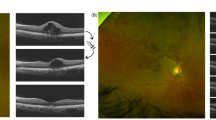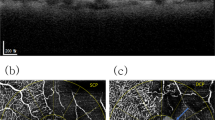Abstract
Purpose
To measure unaffected retinal vessel diameter in eyes with macular edema (ME) secondary to branch retinal vein occlusion (BRVO) after intravitreal injection with bevacizumab (IVB).
Methods
Patients with BRVO-induced ME who responded to IVB were assessed at baseline and 1, 3, and 6 months. In both eyes, the diameters of the largest arteriole and venule in all quadrants (except occlusion quadrant) were measured by using a computer-assisted method. The same vessels chosen at baseline were measured at each follow-up examination.
Results
Forty-two eyes were participated. At baseline, venular diameters of unaffected quadrants in eyes with BRVO were larger than the venules in the corresponding quadrant of the fellow eyes (p < 0.05, respectively). The venular diameters in all quadrants of the affected eyes decreased significantly relative to baseline after IVB (p < 0.05 respectively). Twenty-two eyes (52.4 %) developed recurrent ME. On recurrence at 3 (n = 15, 35.7 %) or 6 months (n = 7, 16.7 %), the unaffected venular diameters increased significantly (p < 0.05 respectively). These diameters again decreased significantly after a second IVB (p < 0.05 respectively).
Conclusion
Unaffected retinal venular diameters associate with the course of BRVO with ME. This may help elucidate the pathological mechanism underlying BRVO.




Similar content being viewed by others
References
Rehak J, Rehak M (2008) Branch retinal vein occlusion: pathogenesis, visual prognosis, and treatment modalities. Curr Eye Res 33:111–131
Hayreh SS (2005) Prevalent misconceptions about acute retinal vascular occlusive disorders. Prog Retin Eye Res 24:493–519
Rogers S, McIntosh RL, Cheung N, Lim L, Wang JJ, Mitchell P, Kowalski JW, Nguyen H, Wong TY, International Eye Disease C (2010) The prevalence of retinal vein occlusion: pooled data from population studies from the United States, Europe, Asia, and Australia. Ophthalmology 117:313–319
Lim LL, Cheung N, Wang JJ, Islam FM, Mitchell P, Saw SM, Aung T, Wong TY (2008) Prevalence and risk factors of retinal vein occlusion in an Asian population. Br J Ophthalmol 92:1316–1319
Jaulim A, Ahmed B, Khanam T, Chatziralli IP (2013) Branch retinal vein occlusion: epidemiology, pathogenesis, risk factors, clinical features, diagnosis, and complications. An update of the literature. Retina 33:901–910
Staurenghi G, Lonati C, Aschero M, Orzalesi N (1994) Arteriovenous crossing as a risk factor in branch retinal vein occlusion. Am J Ophthalmol 117:211–213
Fraenkl SA, Mozaffarieh M, Flammer J (2010) Retinal vein occlusions: the potential impact of a dysregulation of the retinal veins. EPMA J 1:253–261
Kaneda S, Miyazaki D, Sasaki S, Yakura K, Terasaka Y, Miyake K, Ikeda Y, Funakoshi T, Baba T, Yamasaki A, Inoue Y (2011) Multivariate analyses of inflammatory cytokines in eyes with branch retinal vein occlusion: relationships to bevacizumab treatment. Invest Ophthalmol Vis Sci 52:2982–2988
Campochiaro PA, Heier JS, Feiner L, Gray S, Saroj N, Rundle AC, Murahashi WY, Rubio RG, Investigators B (2010) Ranibizumab for macular edema following branch retinal vein occlusion: six-month primary end point results of a phase III study. Ophthalmology 117:1102–1112
Paques M, Krivosic V, Girmens JF, Giraud C, Sahel J, Gaudric A (2005) Decreased venous tortuosity associated with resolution of macular edema after intravitreal injection of triamcinolone. Retina 25:1099–1101
Sacu S, Pemp B, Weigert G, Matt G, Garhofer G, Pruente C, Schmetterer L, Schmidt-Erfurth U (2011) Response of retinal vessels and retrobulbar hemodynamics to intravitreal anti-VEGF treatment in eyes with branch retinal vein occlusion. Invest Ophthalmol Vis Sci 52:3046–3050
Schoenborn CA, Adams PE (2010) Health behaviors of adults: United States, 2005–2007. Vital Health Stat 10:1–132
Diabetic retinopathy study. Report Number 6. Design, methods, and baseline results. Report Number 7. A modification of the Airlie House classification of diabetic retinopathy. Prepared by the Diabetic Retinopathy (1981). Invest Ophthalmol Vis Sci 21:1–226
Pe’er J, Folberg R, Itin A, Gnessin H, Hemo I, Keshet E (1998) Vascular endothelial growth factor upregulation in human central retinal vein occlusion. Ophthalmology 105:412–416
Tilton RG, Chang KC, LeJeune WS, Stephan CC, Brock TA, Williamson JR (1999) Role for nitric oxide in the hyperpermeability and hemodynamic changes induced by intravenous VEGF. Invest Ophthalmol Vis Sci 40:689–696
Wu HM, Huang Q, Yuan Y, Granger HJ (1996) VEGF induces NO-dependent hyperpermeability in coronary venules. Am J Physiol 271:H2735–2739
Hood JD, Meininger CJ, Ziche M, Granger HJ (1998) VEGF upregulates ecNOS message, protein, and NO production in human endothelial cells. Am J Physiol 274:H1054–1058
Stefansson E, Pedersen DB, Jensen PK, la Cour M, Kiilgaard JF, Bang K, Eysteinsson T (2005) Optic nerve oxygenation. Prog Retin Eye Res 24:307–332
Michelson G, Warntges S, Baleanu D, Welzenbach J, Ohno-Jinno A, Pogorelov P, Harazny J (2007) Morphometric age-related evaluation of small retinal vessels by scanning laser Doppler flowmetry: determination of a vessel wall index. Retina 27:490–498
Krohne TU, Eter N, Holz FG, Meyer CH (2008) Intraocular pharmacokinetics of bevacizumab after a single intravitreal injection in humans. Am J Ophthalmol 146:508–512
Wu L, Arevalo JF, Roca JA, Maia M, Berrocal MH, Rodriguez FJ, Evans T, Costa RA, Cardillo J, Pan-American Collaborative Retina Study G (2008) Comparison of two doses of intravitreal bevacizumab (Avastin) for treatment of macular edema secondary to branch retinal vein occlusion: results from the Pan-American Collaborative Retina Study Group at 6 months of follow-up. Retina 28:212–219
Badala F (2008) The treatment of branch retinal vein occlusion with bevacizumab. Curr Opin Ophthalmol 19:234–238
Nguyen TT, Wang JJ, Sharrett AR, Islam FM, Klein R, Klein BE, Cotch MF, Wong TY (2008) Relationship of retinal vascular caliber with diabetes and retinopathy: the Multi-Ethnic Study of Atherosclerosis (MESA). Diabetes Care 31:544–549
Wong TY, Klein R, Sharrett AR, Duncan BB, Couper DJ, Tielsch JM, Klein BE, Hubbard LD (2002) Retinal arteriolar narrowing and risk of coronary heart disease in men and women. The Atherosclerosis Risk in Communities Study. JAMA 287:1153–1159
Acknowledgments
This research was supported by the Basic Science Research Program through the National Research Foundation of Korea (NRF), funded by the Ministry of Education (NRF-2014R1A1A2055007), and by the Korea Health Technology R&D Project through the Korea Health Industry Development Institute (KHIDI), funded by the Ministry of Health & Welfare, Republic of Korea (A111345). The authors are grateful to Professor Nicola Ferrier and Dr. Amitha Domalpally (University of Wisconsin–Madison) for generously providing the IVAN analysis program.
Funding
Ministry of Education provided financial support in the form of the Basic Science Research Program through the National Research Foundation of Korea (NRF) (NRF-2014R1A1A2055007). Ministry of Health & Welfare provided financial support in the form of the Korea Health Technology R&D Project through the Korea Health Industry Development Institute (KHIDI) (A111345). The sponsor had no role in the design or conduct of this research.
Conflict of interest
All authors certify that they have no affiliations with or involvement in any organization or entity with any financial interest (such as honoraria; educational grants; participation in speakers’ bureaus; membership, employment, consultancies, stock ownership, or other equity interest; and expert testimony or patent-licensing arrangements), or non-financial interest (such as personal or professional relationships, affiliations, knowledge, or beliefs) in the subject matter or materials discussed in this manuscript.
Ethical approval
All procedures performed in studies involving human participants were in accordance with the ethical standards of the institutional and/or national research committee and with the 1964 Helsinki Declaration and its later amendments or comparable ethical standards.
For this type of study formal consent is not required.
Informed consent
Informed consent was obtained from all individual participants included in the study.
Author information
Authors and Affiliations
Corresponding author
Rights and permissions
About this article
Cite this article
Im, J.C., Shin, J.P., Kim, I.T. et al. Recurrence of macular edema in eyes with branch retinal vein occlusion changes the diameter of unaffected retinal vessels. Graefes Arch Clin Exp Ophthalmol 254, 1267–1274 (2016). https://doi.org/10.1007/s00417-015-3175-z
Received:
Revised:
Accepted:
Published:
Issue Date:
DOI: https://doi.org/10.1007/s00417-015-3175-z




